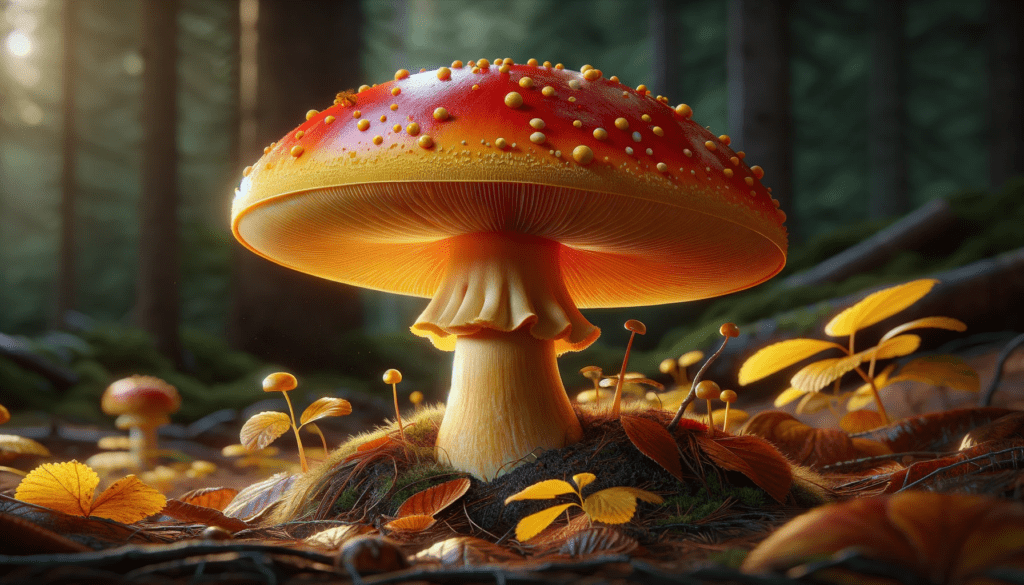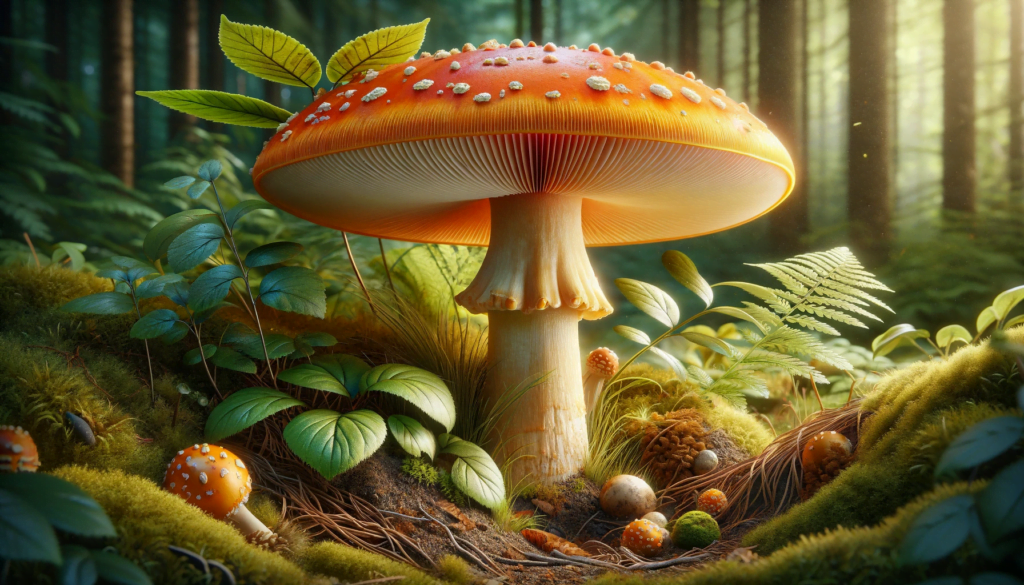Mushrooms possess a unique ability to captivate our senses. From their earthy aroma to their diverse textures and flavors, they offer a world of culinary exploration. The Amanita Caesarea is a fascinating fungus. It is also known as the Caesar’s mushroom. It is regal and delicious. This article is about Amanita Caesarea. We discuss its history, how it is used in cooking, and why it is important to identify it correctly.
A Royal History:

Amanita Caesarea has a long history. It is famous for its food and importance in history. Its very name, “Caesarea,” conjures images of emperors and rulers, hinting at a connection to the aristocracy and elite of ancient times. This mushroom’s regal name isn’t mere happenstance; it was considered a delicacy worthy of royalty.
Diving into the annals of history, we uncover a fascinating chapter—the Amanita Caesarea’s role in the culinary world of the Roman Empire. They say that even Julius Caesar loved this delicious mushroom, which is why it’s called that. During the Roman Empire, this mushroom was valued for its delicious taste and health benefits.
In the old kitchens, the Amanita Caesarea was the best. Emperors and important people ate it. The delicate taste and ability to use it in many dishes made it valued in Roman cooking. Not tasty, it was also thought to have healing powers, making it desired.
As we savor the rich history of the Amanita Caesarea, we can’t help but appreciate the enduring legacy of this noble mushroom. Some cooking treasures have lasted for a long time and crossed borders, leaving a lasting impact on our shared food heritage. When we eat this special mushroom, we taste its deliciousness and remember its grandeur.
So, the next time you encounter the Amanita Caesarea, consider the centuries of history it carries with it. When you eat a mushroom, you’re not enjoying it, but also joining a beloved culinary tradition. It’s a delightful journey through time and taste—an experience fit for royalty.
Identification and Safety:

Amanita Caesarea is a valuable mushroom. Be careful when searching for mushrooms. Some mushrooms that look alike aren’t safe to eat, like the Amanita Muscaria, which is toxic. It’s important to have proper identification when foraging so your adventures are enjoyable and safe.
To tell the Amanita Caesarea apart from similar but dangerous mushrooms, look for these traits:
- The Amanita Caesarea is usually red-orange with a bit of yellow in the middle. Its stem, in contrast, is often pale and adorned with a delicate, skirt-like ring. Be careful if you see mushrooms with bright red or yellow caps. They could be a different kind.
- Gills: Take a close look at the gills of the mushroom. In the case of Amanita Caesarea, its gills are white and free. This means that they do not attach to the stem but instead appear as distinct, radiating spokes from the center. Be wary of mushrooms with attached gills or those that do not exhibit a pristine white color.
- Veil: A distinguishing feature of Amanita Caesarea is the presence of a distinctive cover. This veil is evident in the form of a ring on the upper stem, known as an annulus. If you spot this ring, it’s a reassuring indicator that you might indeed have stumbled upon the coveted Amanita Caesarea.
- Location: The habitat in which the mushroom is found can provide valuable clues for identification. Amanita Caesarea is often found in southern Europe. It is especially common in places with Mediterranean climates. It often establishes its presence in association with oak and pine trees. Knowing where this mushroom typically grows can greatly assist you in finding the real thing.
To stay safe while looking for wild mushrooms, it’s wise to ask experienced mycologists or experts for help. These experts can give you valuable advice and make sure your foraging is fun and safe. When dealing with wild mushrooms, a little knowledge can keep you safe and enhance your cooking experience.
Amanita Caesarea Culinary Excellence:

The Amanita Caesarea is famous for its history and tastes good. Described as delicate with a subtle nuttiness and a hint of citrus, it has the potential to elevate various dishes to a regal status. When prepared, its texture is a perfect balance of tenderness and firmness, making it great for many dishes.
Here are some Amanita Caesarea: A culinary delicacy ideas to help you make the most of this royal mushroom:
- Sautéed Splendor: Opt for a simple sauté preparation. Heat a pan, add a generous knob of butter, minced garlic, and a sprinkle of fresh herbs. Toss in the Amanita Caesarea and let it sizzle. This method allows the natural flavors of the mushroom to take center stage. You can serve it as a delectable side dish or incorporate it over pasta for a regal experience.
- Make your breakfast or brunch fancy by adding sliced Amanita Caesarea to frittatas or omelets. Its unique flavor will infuse your morning meal with a touch of sophistication.
- Add a delightful crunch and earthy, citrusy twist to your salads by slicing raw Amanita Caesarea. Its subtle yet distinctive taste can breathe new life into your greens.
- Risotto: Elevate your risotto game by chopping Amanita Caesarea and incorporating it into the dish. The mushroom’s flavor enhances the creamy rice, adding a sophisticated twist to a classic dish.
- Carpaccio: Impress your guests with an elegant appetizer by creating a mushroom carpaccio. Thinly slice the Amanita Caesarea and arrange it on a plate. Drizzle with high-quality olive oil, a squeeze of fresh lemon juice, and a sprinkling of Parmesan cheese. This stunning and flavorful dish will set the tone for a memorable dining experience.
Amanita Caesarea is tasty and can be used for fancy dinners or everyday meals. Embrace its royal heritage and let your creativity flourish in the kitchen, turning each dish into a masterpiece fit for an emperor’s table. Happy cooking!
Conclusion:
The Amanita Caesarea mushroom is famous in the culinary world for its rich history and prestige. It is often called the Caesar’s mushroom. This food has a great taste and is connected to powerful people, so it is regarded in cooking. However, it’s important to remember that even in the presence of culinary royalty, safety should remain a top priority.
To have a safe and memorable time cooking with wild mushrooms, you must identify them. Amanita Caesarea is a treasure, but not all mushrooms that look similar are safe to eat. The world of mushrooms has some dangerous ones, so it’s important to identify them. A wrong move could be risky.
To safely enjoy the delicious taste of Amanita Caesarea, keep these precautions in mind:
- Knowledge is Key: Educate yourself about the distinct characteristics of Amanita Caesarea. Pay close attention to its color, gills, veil, and preferred habitat. Familiarize yourself with its look-alikes and their differences.
- If you’re new to mushroom foraging, ask experienced mycologists or local experts for guidance. They can provide valuable insights and help you differentiate between safe and toxic species.
- Careful Observation: While in the field, approach each mushroom with a discerning eye. Take your time to carefully observe and assess its features. Remember that haste can lead to errors.
- Remember to document your mushroom finds by taking photos or making detailed notes. This documentation can be useful for later verification and learning purposes.
- Err on the Side of Caution: If you have any doubts about the identity of a mushroom, it’s best to leave it untouched. Consuming a wild mushroom without complete certainty can be risky.
- Local Variations: Be aware that mushroom species and their toxicity can vary by region. What’s safe in one area may not be safe in another, so consider local variations when foraging.
- Keep learning about mushrooms to stay informed about which ones are safe to eat. The world of mycology is a dynamic field with ongoing discoveries.
To sum up, the Amanita Caesarea mushroom is a valuable food with a rich history. However, we must remember to be cautious when dealing with wild mushrooms. By learning and receiving guidance, you can enjoy the delicious taste of this particular mushroom and have a safe cooking experience. When exploring wild mushrooms, approach the Caesar’s mushroom with respect and awe. Its royal taste is best enjoyed wisely. Happy foraging and bon appétit!



